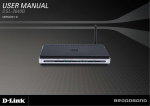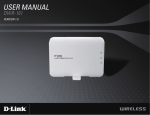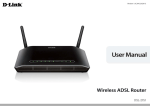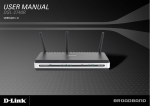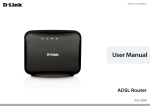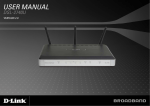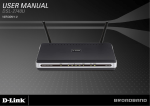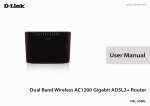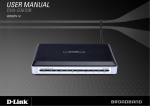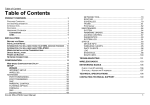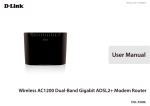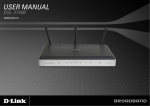Download D-Link DSL-2740R Specifications
Transcript
Table of Contents Table of Contents Product Overview........................................................................................ 3 Package Contents............................................................................................ 3 System Requirements..................................................................................... 4 Introduction....................................................................................................... 5 Features............................................................................................................... 6 Hardware Overview......................................................................................... 7 Connections........................................................................................ 7 Hardware Overview......................................................................................... 8 LEDs........................................................................................................ 8 Installation.................................................................................................... 9 Before you Begin.............................................................................................. 9 Installation Notes...........................................................................................10 Information you will need from your ADSL service provider.........12 Information you will need about the DSL-2740R...............................14 Information you will need about your LAN or computer................15 Wireless Installation Notes..........................................................................16 Device Installation.........................................................................................17 Power on Router.............................................................................................17 Factory Reset Button.....................................................................................18 Network Connections .................................................................................18 Configuration.............................................................................................20 Web-based Configuration Utility..............................................................20 Setup Wizard....................................................................................................21 Internet Setup.................................................................................................26 Wireless..............................................................................................................29 Local Network..................................................................................................38 D-Link DSL-2740R Time....................................................................................................................40 Logout.......................................................................................................42 Advanced.................................................................................................43 Port Forwarding.....................................................................................43 Application Rules...........................................................................................44 Inbound Filter..................................................................................................45 IP/Mac Filter.....................................................................................................46 DNS Setup.........................................................................................................47 Firewall & DMZ................................................................................................49 Advanced Wireless.........................................................................................51 Wi-Fi Protected Setup . ................................................................................53 Advanced LAN.................................................................................................54 Maintenance....................................................................................................55 Password...........................................................................................................55 Save/Restore Settings...................................................................................56 Firmware Update............................................................................................57 Diagnostics..............................................................................................58 System Log.......................................................................................................59 Status..................................................................................................................60 Device Info........................................................................................................60 Connected Clients..........................................................................................63 Statistics.............................................................................................................64 Troubleshooting........................................................................................66 Wireless Basics...........................................................................................68 Networking Basics.....................................................................................71 Technical Specifications...........................................................................73 2 Section 1 - Product Overview Product Overview Package Contents • DSL-2740R Wireless N ADSL2+ Modem Router • 2 non-detachable Antennas (MIMO 2x2) • Power Adapter • CD-ROM with Installation Wizard, User Manual, and Special Offers • One twisted-pair telephone cable used for ADSL connection • One straight-through Ethernet cable • One Quick Installation Guide Note: Using a power supply with a different voltage rating (12 V/ 1 A) than the one included with the DSL-2740R will cause damage and void the warranty for this product. D-Link DSL-2740R 3 Section 1 - Product Overview System Requirements • ADSL Internet service • Computer with: • 200MHz Processor • 64 MB Memory • CD-ROM Drive • Ethernet Adapter with TCP/IP installed • Windows 7/Vista/XP/2000 • MAC OS • Internet Explorer 6 or higher, FireFox 1.5 • D-Link Click’s Connect Utility D-Link DSL-2740R 4 Section 1 - Product Overview Introduction High-Speed ADSL2/2+ Internet Connection Latest ADSL2/2+ standards provide Internet transmission speeds of up to 24 Mbps downstream and 1 Mbps upstream.* High-Performance Wireless Embedded 802.11n technology for high-speed wireless connection, complete compatibility with 802.11b/g wireless devices. Total Security Firewall protection from Internet attacks, user access control, WPA/WPA2 wireless security. Ultimate Internet Connection The DSL-2740R ADSL2+ Router is a versatile, high-performance remote router for home and the small office. With integrated ADSL2/2+ supporting download speeds of up to 24 Mbps, firewall protection, Quality of Service (QoS), 802.11n wireless LAN, and 4 Ethernet switch ports, this router provides all the functions that a home or small office needs to establish a secure and high-speed remote link to the outside world. Ultimate Wireless Connection With Maximum Security This router provides maximum wireless performance. Just connect this router to a computer interface and stay connected from virtually anywhere at home and in the office. The router can be used with 802.11b/g/n wireless networks to enable significantly improved reception. It supports WPA/ WPA2 and WEP for flexible user access security and data encryption methods. Firewall Protection & QoS Security features prevents unauthorized access to your home or office network, be it from wireless devices or from the Internet. The router provides firewall security using Stateful Packet Inspection (SPI) and hacker attack logging for Denial of Service (DoS) attack protection. SPI inspects the contents of all incoming packet headers before deciding what packets are allowed to pass through. Router access control is featured with packet filtering based on port and source/destination MAC/IP addresses. For Quality of Service (QoS), the router supports multiple priority queues in order to enable a group of home or office users to experience the benefit of having a smooth network connection of inbound and outbound data without being concerned about traffic congestion. This QoS support allows users to enjoy a fast ADSL transmission for applications such as VoIP and streaming multimedia over the Internet. *Maximum wireless signal rate derived from IEEE standard 802.11n specifications. Actual data throughput will vary. Network conditions and environmental factors, including volume of network traffic, building materials, and construction, and network overhead, can lower the actual data throughput rate. Environmental factors will adversely affect wireless signal range. D-Link DSL-2740R 5 Section 1 - Product Overview Features • Faster Wireless Networking - The DSL-2740R provides a wireless connection of up to 300 Mbps* with other 802.11n wireless clients. This capability allows users to fully participate in real-time activities online, such as video streaming, online gaming, and real-time audio. • Compatible with 802.11b and 802.11g Devices - The DSL-2740R is still fully compatible with the IEEE 802.11b and g standards, so it can connect with existing 802.11b and g PCI, USB, and Cardbus adapters. • DHCP Support - Dynamic Host Configuration Protocol automatically and dynamically assigns all LAN IP settings to each host on your network. This eliminates the need to reconfigure every host whenever changes in network topology occur. • Network Address Translation (NAT) - For small office environments, the DSL-2740R allows multiple users on the LAN to access the Internet concurrently through a single Internet account. This provides Internet access to everyone in the office for the price of a single user. NAT improves network security in effect by hiding the private network behind one global and visible IP address. NAT address mapping can also be used to link two IP domains via a LAN-to-LAN connection. • Precise ATM Traffic Shaping - Traffic shaping is a method of controlling the flow rate of ATM data cells. This function helps to establish the Quality of Service for ATM data transfer. • High Performance - Very high rates of data transfer are possible with the Router including a downsteam bit rate of up to 24 Mbps using the G.dmt standard. (For ADSL2+) • Full Network Management - The DSL-2740R incorporates SNMP (Simple Network Management Protocol) support for web-based management and text-based network management via Telnet connection. • Easy Installation - The DSL-2740R uses a web-based graphical user interface program for convenient management access and easy setup. Any common web browser software can be used to manage the router. *Maximum wireless signal rate derived from IEEE standard 802.11n specifications. Actual data throughput will vary. Network conditions and environmental factors, including volume of network traffic, building materials and construction, and network overhead, can lower the actual data throughput rate. Environmental factors will adversely affect wireless signal range. D-Link DSL-2740R 6 Section 1 - Product Overview Hardware Overview Connections RESET BUTTON To manually reset the device, depress the button with the power on for between ten and fifteen seconds. ADSL PORT Use the ADSL cable to connect to your telephone line (RJ-11 port). FOUR ETHERNET PORTS Use the Ethernet ports to connect the router to your Ethernet LAN or Ethernet devices. D-Link DSL-2740R WIRELESS ON/OFF SWITCH Turns wireless function on or off. POWER INSERT Use the adapter shipped with the router to connect to a power source. POWER BUTTON Press this button to turn the unit on or off. 7 Section 1 - Product Overview Hardware Overview LEDs POWER A steady green light indicates the unit is powered on. When the device is powered off, this is dark. DSL A steady green light indicates a valid ADSL connection. This will light after the ADSL negotiation process has been settled. A blinking green light indicates activity on the WAN (ADSL) interface. WLAN A steady green light indicates a wireless connection. A blinking green light indicates activity on the WLAN. LAN A solid green light indicates a valid link at startup. These lights blink when there is a connection on any of the Ethernet ports. D-Link DSL-2740R INTERNET A steady green light indicates a successful Internet connection. A steady red light indicates a failed Internet connection. The LED is dark if the router is powered off. 8 Section 2 - Installation Installation This section will walk you through the installation process. Placement of the router is very important. Do not place the router in an enclosed area such as a closet, cabinet, or in the attic or garage. Before you Begin Please read and make sure you understand all the prerequisites for proper installation of your new router. Have all the necessary information and equipment on hand before beginning the installation. D-Link DSL-2740R 9 Section 2 - Installation Installation Notes In order to establish a connection to the Internet it will be necessary to provide information to the router that will be stored in its memory. For some users, only their account information (Username and Password) is required. For others, various parameters that control and define the Internet connection will be required. You can print out the two pages below and use the tables to list this information. This way you have a hard copy of all the information needed to setup the router. If it is necessary to reconfigure the device, all the necessary information can be easily accessed. Be sure to keep this information safe and private. Low Pass Filters Since ADSL and telephone services share the same copper wiring to carry their respective signals, a filtering mechanism may be necessary to avoid mutual interference. A low pass filter device can be installed for each telephone that shares the line with the ADSL line. These filters are easy to install passive devices that connect to the ADSL device and/or telephone using standard telephone cable. Ask your service provider for more information about the use of low pass filters with your installation. Operating Systems The DSL-2740R uses an HTML-based web interface for setup and management. The web configuration manager may be accessed using any operating system capable of running web browser software, including Windows 98 SE, Windows ME, Windows 2000, and Windows XP. Web Browser Any mainstream web browser can be used to configure the router using the web configuration management software. The program is designed to work best with more recently released browsers such as Opera, Microsoft Internet Explorer® version 6.0, Netscape Navigator® version 6.2.3, or later versions. The web browser must have JavaScript enabled. JavaScript is enabled by default on many browsers. Make sure JavaScript has not been disabled by other software (such as virus protection or web user security packages) that may be running on your computer. Ethernet Port (NIC Adapter) Any computer that uses the router must be able to connect to it through the Ethernet port on the router. This connection is an Ethernet connection and therefore requires that your computer be equipped with an Ethernet port as well. Most notebook computers are now sold with an Ethernet port already installed. Likewise, most fully assembled desktop computers come with an Ethernet NIC adapter as standard equipment. If your computer does not have an Ethernet port, you must install an Ethernet NIC adapter before you can use the router. If you must install an adapter, follow the installation instructions that come with the Ethernet NIC adapter. D-Link DSL-2740R 10 Section 2 - Installation 802.11 Wireless LAN Configuration All the 802.11 wireless LAN settings may be configured on a single page using the web-based manager. For basic wireless communication you need to decide what channel to use and what SSID to assign. These two settings must be the same for any wireless workstations or other wireless access point that communicate with the DSL-2740R through the wireless interface. Security for wireless communication can be accomplished in a number of ways. The DSL-2740R supports WPA (Wi-Fi Protected Access), WPA2, and mixed WPA/WPA2. Wireless access can also be controlled by selecting MAC addresses that are allowed to associate with the device. Please read the section on Wireless Configuration. Additional Software It may be necessary to install software on your computer that enables the computer to access the Internet. Additional software must be installed if you are using the device as a simple bridge. For a bridged connection, the information needed to make and maintain the Internet connection is stored on another computer or gateway device, not in the router itself. If your ADSL service is being delivered through a PPPoE or PPPoA connection, the information needed to establish and maintain the Internet connection can be stored in the router. In this case, it is not necessary to install software on your computer. It may however be necessary to change some settings in the device, including account information used to identify and verify the connection. All connections to the Internet require a unique global IP address. For bridged connections, the global IP settings must reside in a TCP/IP enabled device on the LAN side of the bridge, such as a PC, a server, a gateway device such as a router, or similar firewall hardware. The IP address can be assigned in a number of ways. Your network service provider will give you instructions about any additional connection software or NIC configuration that may be required. D-Link DSL-2740R 11 Section 2 - Installation Information you will need from your ADSL service provider Username This is the username used to log on to your ADSL service provider’s network. It is commonly in the form [email protected]. Your ADSL service provider uses this to identify your account. Password This is the password used, in conjunction with the Username above, to log on to your ADSL service provider’s network. This is used to verify the identity of your account. WAN Setting / Connection Type These settings describe the method your ADSL service provider uses to transport data between the Internet and your computer. Most users will use the default settings. You may need to specify one of the following WAN Setting and Connection Type configurations (Connection Type settings listed in parenthesis): • PPPoE/PPoA (PPPoE LLC, PPPoA LLC or PPPoA VC-Mux) • Bridge Mode (1483 Bridged IP LLC or 1483 Bridged IP VC Mux) • IPoA/MER (Static IP Address) (Bridged IP LLC, 1483 Bridged IP VC Mux, 1483 Routed IP LLC, 1483 Routed IP VC-Mux or IPoA) • MER (Dynamic IP Address) (1483 Bridged IP LLC or 1483 Bridged IP VC-Mux) Modulation Type ADSL uses various standardized modulation techniques to transmit data over the allotted signal frequencies. Some users may need to change the type of modulation used for their service. The default DSL modulation (ADSL2+ Multi-Mode) used for the router automatically detects all types of ADSL, ADSL2, and ADSL2+ modulation. However, if you are instructed to specify the modulation type used for the router, you may choose among the numerous options available on the Modulation Type drop-down menu on the ADSL Configuration window (Advanced > ADSL). Security Protocol This is the method your ADSL service provider will use to verify your username and password when you log on to their network. Your router supports the PAP and CHAP protocols. D-Link DSL-2740R 12 Section 2 - Installation VPI Most users will not be required to change this setting. The Virtual Path Identifier (VPI) is used in conjunction with the Virtual Channel Identifier (VCI) to identify the data path between your ADSL service provider’s network and your computer. If you are setting up the router for multiple virtual connections, you will need to configure the VPI and VCI as instructed by your ADSL service provider for the additional connections. This setting can be changed in the WAN Settings window of the web management interface. VCI Most users will not be required to change this setting. The Virtual Channel Identifier (VCI) used in conjunction with the VPI to identify the data path between your ADSL service provider’s network and your computer. If you are setting up the router for multiple virtual connections, you will need to configure the VPI and VCI as instructed by your ADSL service provider for the additional connections. This setting can be changed in the WAN Settings window of the web management interface. D-Link DSL-2740R 13 Section 2 - Installation Information you will need about the DSL-2740R Username This is the username needed to access the router’s management interface. When you attempt to connect to the device through a web browser you will be prompted to enter this username. The default username for the router is “admin.” The user cannot change this. Password This is the password you will be prompted to enter when you access the router’s management interface. The default Password is “admin.” The user may change this. LAN IP addresses for the DSL-2740R This is the IP address you will enter into the Address field of your web browser to access the router’s configuration graphical user interface (GUI) using a web browser. The default IP address is 192.168.1.1. This may be changed to suit any IP address scheme the user desires. This address will be the base IP address used for DHCP service on the LAN when DHCP is enabled. LAN Subnet Mask for the DSL-2740R This is the subnet mask used by the DSL-2740R, and will be used throughout your LAN. The default subnet mask is 255.255.255.0. This can be changed later. D-Link DSL-2740R 14 Section 2 - Installation Information you will need about your LAN or computer Ethernet NIC If your computer has an Ethernet NIC, you can connect the DSL-2740R to this Ethernet port using an Ethernet cable. You can also use the Ethernet ports on the DSL-2740R to connect to other computers or Ethernet devices. DHCP Client status Your DSL-2740R ADSL Router is configured, by default, to be a DHCP server. This means that it can assign an IP address, subnet mask, and a default gateway address to computers on your LAN. The default range of IP addresses the DSL-2740R will assign are from 192.168.1.2 to 192.168.1.254. Your computer (or computers) needs to be configured to Obtain an IP address automatically (that is, they need to be configured as DHCP clients). It is recommended that you collect and record this information here, or in some other secure place, in case you have to re-configure your ADSL connection in the future. Once you have the above information, you are ready to setup and configure your DSL-2740R Wireless ADSL Router. D-Link DSL-2740R 15 Section 2 - Installation Wireless Installation Notes DSL-2740R lets you access your network using a wireless connection from virtually anywhere within the operating range of your wireless network. Keep in mind, however, that the number, thickness, and location of walls, ceilings, or other objects that the wireless signals must pass through, may limit the range. Typical ranges vary depending on the types of materials and background RF (radio frequency) noise in your home or business. The key to maximizing wireless range is to follow these basic guidelines: 1. Keep the number of walls and ceilings between the D-Link router and other network devices to a minimum - each wall or ceiling can reduce your adapter’s range from 3-90 feet (1-30 meters.) Position your devices so that the number of walls or ceilings is minimized. 2. Be aware of the direct line between network devices. A wall that is 1.5 feet thick (0.5 meters), at a 45-degree angle appears to be almost 3 feet (1 meter) thick. At a 2-degree angle it looks over 42 feet (14 meters) thick! Position devices so that the signal will travel straight through a wall or ceiling (instead of at an angle) for better reception. 3. Building materials make a difference. A solid metal door or aluminum studs may have a negative effect on range. Try to position access points, wireless routers, and computers so that the signal passes through drywall or open doorways. Materials and objects such as glass, steel, metal, walls with insulation, water (fish tanks), mirrors, file cabinets, brick, and concrete will degrade your wireless signal. 4. Keep your product away (at least 3-6 feet or 1-2 meters) from electrical devices or appliances that generate RF noise. 5. If you are using 2.4GHz cordless phones or X-10 (wireless products such as ceiling fans, lights, and home security systems), your wireless connection may degrade dramatically or drop completely. Make sure your 2.4GHz phone base is as far away from your wireless devices as possible. The base transmits a signal even if the phone in not in use. D-Link DSL-2740R 16 Section 2 - Installation Device Installation The DSL-2740R Wireless ADSL Router maintains three separate interfaces: an Ethernet LAN, a wireless LAN and an ADSL Internet (WAN) connection. Carefully consider the router’s location’s suitability for connectivity for your Ethernet and wireless devices. You must have a functioning broadband connection via a bridge device such as a Cable or ADSL modem in order to use the router’s WAN function. Place the router in a location where it can be connected to various devices as well as to a power source. The router should not be located where it will be exposed to moisture, direct sunlight or excessive heat. Make sure the cables and power cord are placed safely out of the way so they do not create a tripping hazard. As with any electrical appliance, observe common sense safety procedures. The router can be placed on a shelf, desktop, or other stable platform. If possible, you should be able to see the LED indicators on the front if you need to view them for troubleshooting. Power on Router The router must be used with the power adapter included with the device. 1. 2. 3. Insert the AC Power Adapter cord into the power receptacle located on the rear panel of the router and plug the adapter into a suitable nearby power source. Push down the Power button, and you should see the Power LED indicator light up and remain lit. If the Ethernet port is connected to a working device, check the Ethernet Link/Act LED indicators to make sure the connection is valid. The router will attempt to establish the ADSL connection. If the ADSL line is connected and the router is properly configured this should light up after several seconds. If this is the first time installing the device, some settings may need to be changed before the router can establish a connection. D-Link DSL-2740R 17 Section 2 - Installation Factory Reset Button The router may be reset to the original factory default settings by using a ballpoint or paperclip to gently push down the reset button in the following sequence: 1. Press and hold the reset button while the device is powered off. 2. Turn on the power. 3. Wait for 10~15 seconds and then release the reset button. Remember that this will wipe out any settings stored in flash memory including user account information and LAN IP settings. The device settings will be restored to the factory default IP address 192.168.1.1 and the subnet mask 255.255.255.0. The default management Username is “admin” and the default Password is admin. Network Connections Connect ADSL Line Use the ADSL cable included with the router to connect it to a telephone wall socket or receptacle. Plug one end of the cable into the ADSL port (RJ11 receptacle) on the rear panel of the router and insert the other end into the RJ-11 wall socket. If you are using a low pass filter device, follow the instructions included with the device or given to you by your service provider. The ADSL connection represents the WAN interface, the connection to the Internet. It is the physical link to the service provider’s network backbone and ultimately to the Internet. Connect Router to Ethernet The router may be connected to a single computer or Ethernet device through the 10BASE-TX Ethernet port on the rear panel. Any connection to an Ethernet concentrating device such as a switch or hub must operate at a speed of 10/100 Mbps only. When connecting the router to any Ethernet device that is capable of operating at speeds higher than 10 Mbps, be sure that the device has auto-negotiation (NWay) enabled for the connecting port. Use standard twisted-pair cable with RJ-45 connectors. The RJ-45 port on the router is a crossed port (MDI X). Follow standard Ethernet guidelines when deciding what type of cable to use to make this connection. When connecting the router directly to a PC or server, use a normal straight-through cable. You should use a crossed cable when connecting the router to a normal (MDI-X) port on a switch or hub. Use a normal straight-through cable when connecting it to an uplink (MDI-II) port on a hub or switch. The rules governing Ethernet cable lengths apply to the LAN to router connection. Be sure that the cable connecting the LAN to the router does not exceed 100 meters. D-Link DSL-2740R 18 Section 2 - Installation Hub or Switch to Router Connection Connect the router to an uplink port (MDI-II) on an Ethernet hub or switch with a straight-through cable as shown in this diagram. If you wish to reserve the uplink port on the switch or hub for another device, connect to any of the other MDI-X ports (1x, 2x, etc.) with a crossed cable. Computer to Router Connection You can connect the router directly to a 10/100BASE-TX Ethernet adapter card (NIC) installed on a PC using the Ethernet cable provided as shown in this diagram. D-Link DSL-2740R 19 Section 3 - Configuration Configuration This section will show you how to configure your new D-Link wireless router using the web-based configuration utility. Web-based Configuration Utility Connect to the router To configure the WAN connection used by the router it is first necessary to communicate with the router through its management interface, which is HTML-based and can be accessed using a web browser. The easiest way to make sure your computer has the correct IP settings is to configure it to use the DHCP server in the router. The next section describes how to change the IP configuration for a computer running a Windows operating system to be a DHCP client. To access the configuration utility, open a web browser such as Internet Explorer and enter the IP address of the router (192.168.1.1). Type admin for the User Name and admin in the Password field. D-Link DSL-2740R 20 Section 3 - Configuration Setup Wizard This chapter is concerned with using your computer to configure the WAN connection. The following chapter describes the various windows used to configure and monitor the router including how to change IP settings and DHCP server setup. ADSL SETUP Click on Setup Wizard to launch the Setup Wizard. WELCOME TO D-LINK SETUP WIZARD There are four steps for configuring your router. Click on Next to continue. D-Link DSL-2740R 21 Section 3 - Configuration STEP 1: CHANGE YOUR DSL-2740R PASSWORD The default password is admin. In order to secure your network, please modify the password. Note: The Confirm Password entry must be the same as that for New Password. Of course, you can click on Skip to ignore the step. STEP 2: SET TIME AND DATE TIME SETTING: Please enable Automatically synchronize with Internet time servers if you want to use the time server. You can use the default time server web site or type any web server name you want in the First NTP time server and the Second NTP time server fields. Please select the time zone of your country in the Time Zone option. If you need to enable daylight saving time, just click on the Enable Daylight Saving checkbox. Daylight saving is a period from late Spring to early Fall. Configure Daylight Saving Dates Daylight Saving time starts in most parts of the United States on the second Sunday of March. Each time zone in the United States starts Daylight Saving time at 2 A.M. Thus, for the United States you should select March, Second, Sunday, at 2:00 A.M for the Start. D-Link DSL-2740R 22 Section 3 - Configuration Daylight Saving time starts in the European Union on the last Sunday of March. Thus, in the European Union, you must select March, Last, Sunday. The time must depend on your country’s time zone. For example, in Germany you must type 2 because Germany’s time zone is 1 hour ahead of GMT or UTC (GMT+1). Thus, in Germany you must select March, Last, Sunday, at 1:00 A.M. Daylight Saving time ends in most parts of the United States on the first Sunday of November. Each time zone in the United States must use Daylight Saving time at 2:00 A.M. Thus, in the United States you must set November, First, Sunday, at 2:00 A.M for the End. Daylight Saving time ends in the European Union on the last Sunday of October. For instance, in Germany you must type 2 because Germany’s time zone is 1 hour ahead of GMT (GMT+1). Thus, in Germany you must set March, Last, Sunday, at 1:00 A.M for the End. SET THE DATE AND TIME MANUALLY You can also use the Copy Your Computer’s Time Settings to synchronize the Date and Time to your local PC. Or, you can also adjust Year/Month/ Day/Hour/Minute/Second values manually. Click on Next to save the configuration and continue. D-Link DSL-2740R 23 Section 3 - Configuration STEP 3: SELECT INTERNET CONNECTION TYPE Please select your Country and ISP Provider from the list. If you cannot find the country and ISP in the list; you can select Others, and then input the VPI and VCI and Connection Type. Please enter the VPI/VCI numbers if provided by the ISP. Click on Next to save the configuration and continue. Please enter your Username and Password provided by your ISP provider. Click on Next to go to the next Setup Wizard window. D-Link DSL-2740R 24 Section 3 - Configuration STEP 4: CONNECT TO INTERNET Click on APPLY to save the configuration. D-Link DSL-2740R 25 Section 3 - Configuration Internet Setup To access the INTERNET SETUP (WAN) settings window, click on the INTERNET SETUP button in the SETUP directory and select Manual Setup to configure the MANUAL ADSL interface on this page: INTERNET SETUP If you want to type connection configuration for various types, please enable Manual Setup. MANUAL ADSL CONNECTION SETUP PPPoE/PPPoA Choose this option if your ISP uses PPPoE/PPPoA.(For most DSL users) Dynamic IP Address Choose this option if your ISP uses Dynamic IP Address over DSL. Static IP Address Choose this option if your ISP uses Static IP assignments. Bridge Choose this option if your ISP uses Bridge. D-Link DSL-2740R 26 Section 3 - Configuration For PPPoE/PPPoA connection Type the Username and Password (and PPPoE Service Name, if required by your ISP). Type the service name from your ISP in Servername. Choose PPPoE LLC/Snap-Bridging, PPPoE VC-mux, PPPoA LLC/ encapsulation or PPPoA VC-mux in Connection Type. Type the MTU value which you want (it should be less than 1492) in MTU. Set the time for which if your data doesn’t pass through the connection, it will be disconnected in Idle Time Out. The default time is 0 and it means it is always on. DNS AND DEFAULT GATEWAY Select Obtain DNS server address automatically to get DNS from your ISP. Or Select Use the following DNS server addresses to type the DNS IPs in the Preferred DNS server and Alternate DNS server. D-Link DSL-2740R 27 Section 3 - Configuration Type the PVC values which are from your ISP in VPI/VCI. Select Enable NAT when you want to have WAN and LAN. Select Enable Firewall when you want to have the basic filter function, for example, ICMP ping to DSL-2740R. Select Enable IGMP Proxy when you want to let IAD act as a IGMP proxy which can help the proxy server to send IGMP query packets to the IPTV clients. Click on Apply to save the configuration. D-Link DSL-2740R 28 Section 3 - Configuration Wireless Use this section to configure the wireless settings for your D-Link router. Please note that changes made in this section will also need to be duplicated onto your wireless clients and PC. To access the WIRELESS (WLAN) settings window, click on Wireless Setup in the SETUP directory. Wireless Network Setting Click on Wireless Connection Setup Wizard to set up the wireless connection in an easy way. It will use a Web-based Wizard to assist you in connecting to your new D-Link Systems Wireless Router. Note: Before launching the wizard, please make sure you have followed all the steps outlined in the Quick Installation Guide included in the package. Click on the Add Wireless Device with WPS button. This wizard is designed to assist you in connecting your wireless device to your router with WPS. It will guide you using step-by-step instructions on how to get your wireless device connected. If you would like to configure the Internet settings of your new D-Link Router manually, then click on Manual Wireless Connection Setup. D-Link DSL-2740R 29 Section 3 - Configuration Clicking on Wireless Connection Setup Wizard will open the D-Link Wireless Security Setup Wizard. Enable Your Wireless Network Your wireless network is enabled by default. You can simply uncheck the Enable Your Wireless Network checkbox to disable wireless. Network Name (SSID) identifies members of the Service Set. Accept the default name or change it to something else. If the default SSID is changed, all other devices on the wireless network must also use the same SSID. In order to protect your network from hackers and unauthorized users, Auto (WPA or WPA2) security will be used. We provide users a random pre-shared key automatically. You can also set it manually if you do not prefer the key we generate. Type a string (8-63 characters, such as a~z, A~Z, or 0~9) for Pre-Shared Key. Click Prev to go back to the previous page. Click Next to go to the next page. Click Cancel to return to the main menu of the Wireless Setup page. D-Link DSL-2740R 30 Section 3 - Configuration On this page, you can check the Wireless Status, Network Name (SSID), Wireless Security Mode, and Pre-shared Key. Click Prev to go back to the previous page. Click Save to save the configuration and return to the main menu of the Wireless Setup page. Click Cancel to return to the main menu of the Wireless Setup page. Add Wireless Device with WPS Clicking on Add Wireless Device with WPS will open the D-Link Add Wireless Device with WPS (Wi-Fi Protected Setup) Wizard. The wizard provides you the option to set up WPS using either the Auto or Manual methods. Auto -- Select this option if your wireless device supports WPS (Wi-Fi Protected Setup). Manual -- Select this option to display the current wireless settings for you to configure the wireless device manually. Click Next to go to the next page. Click Cancel to return to the main menu of the Wireless Setup page. D-Link DSL-2740R 31 Section 3 - Configuration Add Wireless Device with WPS (Automatically) This page allows you to select the PIN or PBC method for WPS connection. PIN- Enter the PIN code from your wireless device and click Connect to start the handshaking. PBC- Click Connect on your wireless device and press the Connect button on your wireless device within 120 seconds to start the handshaking. Click Prev to go back to the previous page. Add Wireless Device with WPS (WI-FI PROTECTED SETUP) WIZARD This page will count down the timer for you to start WPS on the wireless device you are adding. Add Wireless Device with WPS (Manually) This screen shows the information for the SSID and the Network key that allow you to modify the current setting. If you selected Auto in the previous step, you won’t see this page. Please then refer to the next column. Please type the network name in the Network Name SSID field. Please type the network key in the Network Key field. Click Next to proceed to the next page. D-Link DSL-2740R 32 Section 3 - Configuration Add Wireless Device with WPS (WI-FI PROTECTED SETUP) Wizard It will show the wireless login information. You can check if it is correct, then click Next. Manual WIRELESS Connection Setup SETTINGS Clicking on Manual Wireless Connection Setup on the Wireless Setup page will take you to the Manual Wireless Connection Setup page. Click on Enable Wireless to allow the router to operate in the wireless environment. The SSID identifies members of the Service Set. Accept the default name or change it to something else. If the default SSID is changed, all other devices on the wireless network must also use the same SSID. The Wireless Channel can let you select the channel of your access point. Channel availability is different for different countries due to their regulations. Select 802.11 Mode to operate in b/g/n mode. Or select specified mode to use 802.11b only, 802.11g only, or 802.11n only. Choosing Mixed 802.11g and 802.11b enables the DSL-2740R to detect clients and use 802.11g or 802.11b to synchronize. Choosing Mixed 802.11n, 802.11g and 802.11b enables the DSL-2740R to detect clients and use 802.11n, 802.11g or 802.11b to synchronize. D-Link DSL-2740R 33 Section 3 - Configuration Channel Width The maximum rate for 20 MHz/GI=0 is 130 Mbps. The maximum rate for 40 MHz/GI=1 is 300Mbps. Transmission Rate It is suggested that you keep the Best (automatic) selection. This is related to Receive Sensitivity as follows, for example: MCS 0 MCS 1 MCS 2 MCS 3 MCS 4 MCS 5 MCS 6 MCS 7 MCS 8 MCS 9 MCS 10 MCS 11 MCS 12 MCS 13 MCS 14 MCS 15 MANRATE 0x80 0x81 0x82 0x83 0x84 0x85 0x86 0x87 0x88 0x89 0x8a 0x8b 0x8c 0x8d 0x8e 0x8f HT20/GI=0 6.5 Mbps 13 Mbps 19.5 Mbps 26 Mbps 39 Mbps 52 Mbps 58.5 Mbps 65 Mbps 13 Mbps 26 Mbps 39 Mbps 52 Mbps 78 Mbps 104 Mbps 117 Mbps 130 Mbps HT40/GI=0 13.5 Mbps 27 Mbps 40.5 Mbps 54 Mbps 81 Mbps 108 Mbps 121.5 Mbps 135 Mbps 27 Mbps 54 Mbps 81 Mbps 108 Mbps 162 Mbps 216 Mbps 243 Mbps 270 Mbps HT40/GI=1 X X X X X X X 150 Mbps X X X X X X X 300 Mbps Choose Visible or Invisible to decide if you want to broadcast its SSID. D-Link DSL-2740R 34 Section 3 - Configuration WIRELESS SECURITY Mode To protect your privacy you can configure wireless security features. This device supports three wireless security modes including WEP, WPA, and WPA-Personal. WEP is the original wireless encryption standard. WPA provides a higher level of security. WPA-Personal does not require an authentication server. D-Link DSL-2740R 35 Section 3 - Configuration WIRELESS SECURITY MODE - WEP WEP (Wireless Encryption Protocol) encryption can be enabled for security and privacy. WEP encrypts the data portion of each frame transmitted from the wireless adapter using one of the predefined keys. The router offers 64 or 128 bit encryption with four keys available. Select WEP Key Length from the drop-down menu. (128 bit is stronger than 64 bit.) Specify the encryption key from the Current Network Key drop-down menu. Enter up to four keys into the WEP Key fields. Select the Authentication type from the drop-down menu. (Shared is better than Open.) Click on Apply Settings to apply settings. D-Link DSL-2740R 36 Section 3 - Configuration WIRELESS SECURITY MODE – WPA-Personal Use WPA or WPA2 mode to achieve a balance of strong security and best compatibility. This mode uses WPA for legacy clients while maintaining a higher level of security with stations that are WPA2 capable. Also the strongest cipher that the client supports will be used. For best security, use WPA2 Only mode. This mode uses AES (CCMP) cipher and legacy stations are not allowed access with WPA security. For maximum compatibility, use WPA Only. This mode uses TKIP cipher. Some gaming and legacy devices work only in this mode. According to the WiFi Alliance 11N specification, Wi-Fi Protected Setup is not fully supported under WPA Only mode. We will disable your Wi-Fi Protected Setup if you use WPA Only mode. Select Auto(WPA or WPA2) or WPA2 only or WPA only on the WPA Mode. Type the value in seconds on the Group Key Update Interval. The default value is 1800. Type the string on the Pre-Shared Key. Click Apply Settings to save the configuration. D-Link DSL-2740R 37 Section 3 - Configuration Local Network You can configure the LAN IP address to suit your preference. Many users will find it convenient to use the default settings together with DHCP service to manage the IP settings for their private network. The IP address of the router is the base address used for DHCP. In order to use the router for DHCP on your LAN, the IP address pool used for DHCP must be compatible with the IP address of the router. The IP addresses available in the DHCP IP address pool will change automatically if you change the IP address of the router. To access the Local Network settings window, click on Local Network in the SETUP directory. ROUTER SETTINGS To change the Router IP Address or Subnet Mask, type in the desired values. DHCP SERVER SETTINGS (OPTIONAL) The Enable DHCP Server is selected by default for the router’s Ethernet LAN interface. Set the DHCP IP Address Range and the default is from 192.168.1.2 to 192.168.1.254. The IP address pool can be up to 253 IP addresses. Set the DHCP Lease Time in number of hours. The default value is 72. If you don’t want DSL-2740R to be the DHCP server, you can enable DHCP relay to pass the DHCP discover packets of the clients to another DHCP server. Please set the DHCP server IP address in DHCP Server IP Address. D-Link DSL-2740R 38 Section 3 - Configuration ADD/EDIT DHCP RESERVATION (OPTIONAL) Click on the Add button under the DHCP Reservations List. Select Enable to let you reserve the IP Address for the designated PC with the configured MAC Address. The Computer Name can help you recognize this PC with the MAC Address by assigning it a name like “Father’s Laptop.” Click on Copy Your PC’s MAC Address to help you get the Mac address from the PC you are using to browse the web page. Click on Apply to save the configuration. DHCP RESERVATIONS LIST After the DHCP reservation is saved, the DHCP RESERVATIONS LIST will list the configuration. The NUMBER OF DYNAMIC DHCP CLIENTS shows how many DHCP clients (PC or Laptop) are connected to the router currently. Click on Save Settings. You will be asked to reboot by a pop-up window. Click on OK to reboot the router. LAN SETUP Do not turn the router off while it is rebooting. You might need to re-configure your PC NIC settings to enter the router’s web manager after reboot. D-Link DSL-2740R 39 Section 3 - Configuration Time The TIME configuration option allows you to configure, update, and maintain the correct time on the internal system clock. From this section you can set the time zone that you are in and set the NTP (Network Time Protocol) Server. Daylight Saving can also be configured to automatically adjust the time when needed. To access the TIME setting window, click on the Time and Date button in the SETUP directory. TIME Check Enable NTP Server. Select specific time server to use from the NTP Server Used dropdown menu. Or, you can type the specific NTP server name. Select your operating time zone from the Time Zone drop-down menu. If you need to enable daylight saving time, just select Enable Daylight Saving. Daylight saving is a period from late Spring to early Fall. Set how many hours to change the time for Daylight saving Offset. Configure Daylight Saving Dates Daylight Saving time starts in the most parts of the United States on the second Sunday of March. Each time zone in the United States starts Daylight Saving time at 2 A.M. Thus, in the United States, you should use March, Second, Sunday, at 2:00 A.M for the start time. Daylight Saving time starts in the European Union on the last Sunday of March. Thus, in the European Union, you must select March, Last, Sunday for the start time. The time must depend on your country’s time zone. For example, in Germany you must type 2 because Germany’s time zone is 1 hour ahead of GMT or UTC (GMT+1). Thus, in Germany you should use March, Last, Sunday, at 1:00 A.M for the start time. D-Link DSL-2740R 40 Section 3 - Configuration Daylight Saving time ends in most parts of the United States on the first Sunday of November. Each time zone in the United States must use Daylight Saving time at 2:00 A.M. Thus, in the United States you must set November, First, Sunday, at 2:00 A.M as your end time. Daylight Saving time ends in the European Union on the last Sunday of October. For instance, in Germany you must type 2 because Germany’s time zone is 1 hour ahead of GMT (GMT+1). Thus, in Germany you must use March, Last, Sunday, at 1:00 A.M. SET THE DATE AND TIME MANAULLY You can also use Copy Your Computer’s Time Settings to synchronize the Date and Time to your local PC. Or, you can also adjust Year/Month/Day/Hour/Minute/Second manually. Click Apply to save the configurations. D-Link DSL-2740R 41 Section 3 - Configuration Logout The LOGOUT page enables you to log out of your router configuration and closes the browser. To access the LOGOUT setting window, click on Logout in the SETUP directory LOGOUT Click on Logout to log out of the router configuration and close the browser. D-Link DSL-2740R 42 Section 3 - Configuration Advanced This chapter includes the more advanced features used for network management and security as well as administrative tools to manage the router, view status, and other information used to examine performance, and for troubleshooting. Port Forwarding Use the PORT FORWARDING window to open ports in your router and re-direct data through those ports to a single PC on your network (WANto-LAN traffic). The Port Forwarding function allows remote users to access services on your LAN such as FTP for file transfers or SMTP and POP3 for e-mail. The DSL-2740R will accept remote requests for these services at your Global IP Address, using the specified TCP or UDP protocol and port number, and then redirect these requests to the server on your LAN with the LAN IP address you specify. Remember that the specified Private IP Address must be within the useable range of the subnet occupied by the router. To access the PORT FORWARDING settings window, click on PORT FORWARDING in the ADVANCED directory. ACTIVE PORT FORWARDING Click Add to show the ADD PORT FORWARDING page. Type the values for Private IP, Public Start Port, and Public End Port, and choose the Protocol Type. Click Apply to apply the settings. D-Link DSL-2740R 43 Section 3 - Configuration Application Rules Use this feature as parental controls to only grant or block access from applications such as peer-to-peer utilities or games . APPLICATION RULES Select Allow or Deny for applications such as ICQ, MSN, Yahoo messenger, and Real Audio/Video. Click Apply Settings to save the configuration. D-Link DSL-2740R 44 Section 3 - Configuration Inbound Filter By default, all incoming IP traffic from the Internet is allowed. The Inbound Filter allows you to create a filter rule to filter incoming IP traffic by specifying a filter name and at least one condition. All of the specified conditions in this filter rule must be satisfied for the rule to take effect. ADD INBOUND IP FILTER Type the filter name in the Filter Name field. Choose ICMP, TCP/UDP, TCP, or UDP in Protocol. Type the Source IP address, Source Subnet Mask, and Source Port. Type the Destination IP address, Destination Subnet Mask, and Destination port. Please click Add/Apply to add the filter to the list. D-Link DSL-2740R 45 Section 3 - Configuration IP/Mac Filter This is the ability to set filters in the router and re-direct data through those to a single PC on your network. SELECT IP/MAC FILTER RULE INDEX Choose Both, Incoming, or Outgoing in Direction. Type the Source IP address, Subnet Mask, and Port Number. Type Destination IP address, Subnet Mask, and Port Number. Choose ICMP, TCP, or UDP in Protocol. Click Save to add the policy in the list. D-Link DSL-2740R 46 Section 3 - Configuration DNS Setup The DNS is used to resolve the DNS name to IPs. You can type the DNS name or obtain it automatically. The Dynamic DNS feature allows you to host a server (Web, FTP, Game Server, etc.) using a domain name that you have purchased (for example: www.whateveryournameis.com) with your dynamically assigned IP address. Most broadband Internet Service Providers assign dynamic (changing) IP addresses. Using a DDNS service provider, your friends can just enter your host name to connect to your game server without having to know your IP address. To access the DNS setting window, click on the DNS button under the ADVANCED tab. DNS AND DEFAULT GATEWAY If you are using the router for DHCP service on the LAN and are using DNS servers on the ISP’s network, check the Obtain DNS server address automatically box. If you have DNS IP addresses provided by your ISP, enter these IP addresses in the available entry fields for the Preferred DNS Server and the Alternate DNS Server. D-Link DSL-2740R 47 Section 3 - Configuration DDNS CONFIGURATION Please access a DDNS web server to obtain a domain name. You can use the D-Link DDNS server at https://www.dlinkddns.com to receive a free DDNS. Please enable Enable Dynamic DNS if you want to use DDNS. Choose which DDNS web site to use in Server Address. Type the Host name which you registered with your DDNS service provider in Host Name. Type the username/password on the Username/Password/Verify Password of your DDNS account. After you have configured the DNS settings as desired, click Apply to apply the settings. D-Link DSL-2740R 48 Section 3 - Configuration Firewall & DMZ The router already provides a simple firewall by virtue of the way NAT works. By default NAT does not respond to unsolicited incoming requests on any port, thereby making your WAN invisible to Internet cyber attackers. DMZ means Demilitarised Zone. DMZ allows computers behind the router firewall to be accessible to Internet traffic. Typically, your DMZ would contain Web servers, FTP servers, and others. FIREWALL SETTINGS Enable the Firewall by clicking Enable Firewall. Enable the SPI on clicking Enable SPI. Enable the ALG on clicking Enable ALG. D-Link DSL-2740R 49 Section 3 - Configuration DMZ SETTINGS Please select Enable DMZ and type the DMZ client IP in the DMZ IP Address. Or you also can choose the DMZ host using the pulldown menu. Click on Apply Settings to apply these settings. D-Link DSL-2740R 50 Section 3 - Configuration Advanced Wireless These options are for users who wish to change the performance of their 802.11g wireless radio from the standard settings. D-Link does not recommend changing the factory default settings. Incorrect settings may impair the performance of your wireless radio. The default settings should provide the best wireless radio performance in most environments. ADVANCED WIRELESS SETTINGS If you need to change the default behavior, please set the following values: Select from 20 MHz Auto 20/40 MHz on the Channel Width. Select Lower or Upper on the Control Sideband. Select MCS. Please type the Fragmentation Threshold value. Please type the RTS Threshold value. Please type the DTIM Interval value. Please type the Beacon Interval value. D-Link DSL-2740R 51 Section 3 - Configuration GUEST WIRELESS SETTINGS Select how many SSIDs you need in Wireless SSID Num. Please select Enable Wireless Guest Network. Type SSID in Guest SSID1. Click on Apply Settings to apply these settings. D-Link DSL-2740R 52 Section 3 - Configuration Wi-Fi Protected Setup Wi-Fi Protected Setup is used to easily add devices to a network using a PIN or button press. Devices must support Wi-Fi Protected Setup in order to be configured by this method. If the PIN changes, the new PIN will be used in following the Wi-Fi Protected Setup process. Clicking on Cancel will not reset the PIN. However, if the new PIN is not saved, it will get lost when the device reboots or loses power. WI-FI PROTECTED SETUP Please select Enable or Lock Wireless Security Settings You also can click Reset to Unconfigured to reset the wireless setting. PIN SETTINGS Click on Reset PIN to Default or Generate New PIN to show the PIN in the Current PIN field. ADD WIRELESS STATION Please click Add Wireless Device with WPS to set the WPS. D-Link DSL-2740R 53 Section 3 - Configuration Advanced LAN These options are for users that wish to change the LAN settings. D-Link does not recommend changing these settings from factory default. Changing these settings may affect the behavior of your network. UPNP Please select Enable UPnP when you want to have Universal Plug and Play (UPnP) support peer-to-peer Plug and Play functionality for network devices. MULTICAST STREAMS Please click on Enable Multicast Streams (IGMP) to let a IGMP stream pass through DSL-2740R. WAN PING Enable WAN Ping response by clicking Enable WAN Ping. Click on Apply Settings to apply the settings. D-Link DSL-2740R 54 Section 3 - Configuration Maintenance Click on the MAINTENANCE tab to view the window buttons for various functions located in this directory. Password The factory default password of this router is admin. To help secure your network, D-Link recommends that you choose a new password. SET PASSWORD (OPTIONAL) Please type the Current Password, New Password, and Confirm Password. Please click Apply Settings to save the settings. D-Link DSL-2740R 55 Section 3 - Configuration Save/Restore Settings Once the router is configured, you can save the configuration settings to a configuration file on your hard drive. You also have the option to load configuration settings or restore the factory default settings. SAVE/RESTORE CONFIGURATION Please click Save next to Save Settings to Local Hard Drive. Please click Browse to choose the configurations file and then click Update Settings to upload the file. If necessary, please click Restore Device to regain the default settings. Click Write To Flash to write web parameters to flash. All your settings will be saved after restart. D-Link DSL-2740R 56 Section 3 - Configuration Firmware Update Use the FIRMWARE UPGRADE window to load the latest firmware for the device. Note that the device configuration settings may return to the factory default settings, so make sure you first save the configuration settings in the SAVE/RESTORE SETTINGS window described in the previous page. To access the FIRMWARE UPGRADE setting window, click Firmware Update under the MAINTENANCE tab. It shows Current Firmware Version and Current Firmware Date. FIRMWARE UPGRADE To upgrade the firmware, click the Browse… button to search for the firmware file and then click Upload to begin copying the file. The Router will load the file and restart automatically. D-Link DSL-2740R 57 Section 3 - Configuration Diagnostics Your router is capable of testing your DSL connection. The individual tests are listed below. If a test displays a fail status, click Re-run Diagnostics Tests at the bottom of this page to make sure the fail status is consistent. If the test continues to fail, click Help and follow the troubleshooting procedures. SYSTEM CHECK There are two tests: Test your Ethernet(1-4) Connection and Test ADSL Synchronization. They will either show PASS or FAIL. INTERNET CONNECTIVITY CHECK There are three tests: Test the assigned IP address, Ping ISP Default Gateway and Ping Preferred DNS server. They will either show PASS or FAIL. Please click Re-run DiagnosticsTest to run diagnostics again on the above test items. D-Link DSL-2740R 58 Section 3 - Configuration System Log The System Log allows you to configure local, remote and email logging, and to view the logs that have been created. This section allows you to view the logs. D-Link DSL-2740R 59 Section 3 - Configuration Status Click on the STATUS tab to reveal the window buttons for various functions located in this directory. The DEVICE STATUS window is the first item in the STATUS directory. Use these windows to view system information and monitor performance. Device Info The Device Info page displays a summary overview of your router status, including the device software version and summary of your Internet configuration (both wireless and Ethernet status). To access the DEVICE STATUS LOG setting window, click on the Device Info button in the STATUS directory. GENERAL This window displays current system time and the firmware version. D-Link DSL-2740R 60 Section 3 - Configuration INTERNET STATUS This window displays WAN information including IP address, Mask, Default Gateway, Preferred, and Alternate DNS Server. WIRELESS LAN This window displays authenticated wireless stations and their status. D-Link DSL-2740R 61 Section 3 - Configuration LOCAL NETWORK INFO This window displays LAN information including MAC, IP address, Subnet Mask, and DHCP Server. D-Link DSL-2740R 62 Section 3 - Configuration Connected Clients This page shows the connected DHCP clients on the LAN. NUMBER OF DYNAMIC DHCP CLIENTS This window displays all the entities which have linked to the LAN interface successfully. D-Link DSL-2740R 63 Section 3 - Configuration Statistics This information reflects the current status of your router. WAN STATISTICS This window displays all the Receiver and Transmitted packet statistics and status on the WAN interface. LAN STATISTICS This window displays all the Receiver and Transmitted packet statistics and status on the LAN interface. D-Link DSL-2740R 64 Section 3 - Configuration ADSL STATISTICS This window displays the ADSL statistics. D-Link DSL-2740R 65 Section 4 - Troubleshooting Troubleshooting This chapter provides solutions to problems that can occur during the installation and operation of the DSL-2740R. Read the following descriptions if you are having problems. (The examples below are illustrated in Windows® XP. If you have a different operating system, the screenshots on your computer will look similar to the following examples.) 1. Why can’t I access the web-based configuration utility? When entering the IP address of the D-Link router (192.168.1.1 for example), you are not connecting to a website on the Internet and do not need to be connected to the Internet. The device has the utility built-in to a ROM chip in the device itself. Your computer must be on the same IP subnet to connect to the web-based utility. • Make sure you have an updated Java-enabled web browser. We recommend the following: • Internet Explorer 6.0 or higher • Firefox 1.5 or higher • Verify physical connectivity by checking for solid link lights on the device. If you do not get a solid link light, try using a different cable or connect to a different port on the device if possible. If the computer is turned off, the link light may not be on. • Disable any internet security software running on the computer. Software firewalls such as Zone Alarm, Black Ice, Sygate, Norton Personal Firewall, and Windows® XP firewall may block access to the configuration pages. Check the help files included with your firewall software for more information on disabling or configuring it. D-Link DSL-2740R 66 Section 4 - Troubleshooting • Configure your Internet settings: • Go to Start > Settings > Control Panel. Double-click on the Internet Options Icon. From the Security tab, click on the button to restore the settings to their defaults. • Click on the Connection tab and set the dial-up option to Never Dial a Connection. Click on the LAN Settings button. Make sure nothing is checked. Click on the OK. • Go to the Advanced tab and click on the button to restore these settings to their defaults. Click on the OK button three times. • Close your web browser (if open) and open it. • Access the web management. Open your web browser and enter the IP address of your D-Link router in the address bar. This should open the login page for the web management. • If you still cannot access the configuration, unplug the power to the router for 10 seconds and plug back in. Wait about 30 seconds and try accessing the configuration. If you have multiple computers, try connecting using a different computer. 2. What can I do if I forgot my password? If you forgot your password, you must reset your router. Unfortunately this process will change all your settings back to the factory defaults. To reset the router, locate the reset button (hole) on the rear panel of the unit. With the router powered on, use a paperclip to hold the button down for 10 seconds. Release the button and the router will go through its reboot process. Wait about 30 seconds to access the router. The default IP address is 192.168.1.1. When logging in, type in the default User Name “admin,” and the default Password “admin” then click on the OK button to access the web-based manager. D-Link DSL-2740R 67 Appendix A - Wireless Basics Wireless Basics D-Link wireless products are based on industry standards to provide easy-to-use and compatible high-speed wireless connectivity within your home, business or public access wireless networks. Strictly adhering to the IEEE standard, the D-Link wireless family of products will allow you to securely access the data you want, when and where you want it. You will be able to enjoy the freedom that wireless networking delivers. A wireless local area network (WLAN) is a cellular computer network that transmits and receives data with radio signals instead of wires. Wireless LANs are used increasingly in both home and office environments, and public areas such as airports, coffee shops and universities. Innovative ways to utilize WLAN technology are helping people to work and communicate more efficiently. Increased mobility and the absence of cabling and other fixed infrastructure have proven to be beneficial for many users. Wireless users can use the same applications they use on a wired network. Wireless adapter cards used on laptop and desktop systems support the same protocols as Ethernet adapter cards. Under many circumstances, it may be desirable for mobile network devices to link to a conventional Ethernet LAN in order to use servers, printers or an Internet connection supplied through the wired LAN. A Wireless Router is a device used to provide this link. What is Wireless? Wireless or Wi-Fi technology is another way of connecting your computer to the network without using wires. Wi-Fi uses radio frequency to connect wirelessly, so you have the freedom to connect computers anywhere in your home or office network. Why D-Link Wireless? D-Link is the worldwide leader and award winning designer, developer, and manufacturer of networking products. D-Link delivers the performance you need at a price you can afford. D-Link has all the products you need to build your network. How does wireless work? Wireless works similar to how cordless phone work, through radio signals to transmit data from one point A to point B. But wireless technology has restrictions as to how you can access the network. You must be within the wireless network range area to be able to connect your computer. There are two different types of wireless networks Wireless Local Area Network (WLAN), and Wireless Personal Area Network (WPAN). D-Link DSL-2740R 68 Appendix A - Wireless Basics Wireless Local Area Network (WLAN) In a wireless local area network, a device called an Access Point (AP) connects computers to the network. The access point has a small antenna attached to it, which allows it to transmit data back and forth over radio signals. With an indoor access point as seen in the picture, the signal can travel up to 300 feet. With an outdoor access point the signal can reach out up to 30 miles to serve places like manufacturing plants, industrial locations, college and high school campuses, airports, golf courses, and many other outdoor venues. Wireless Personal Area Network (WPAN) Bluetooth is the industry standard wireless technology used for WPAN. Bluetooth devices in WPAN operate in a range up to 30 feet away. Compared to WLAN the speed and wireless operation range are both less than WLAN, but in return it doesn’t use nearly as much power which makes it ideal for personal devices, such as mobile phones, PDAs, headphones, laptops, speakers, and other devices that operate on batteries. Who uses wireless? Wireless technology as become so popular in recent years that almost everyone is using it, whether it’s for home, office, business, D-Link has a wireless solution for it. Home • Gives everyone at home broadband access • Surf the web, check email, instant message, download multimedia files. • Gets rid of the cables around the house • Simple and easy to use Small Office and Home Office • Stay on top of everything at home as you would at the office • Remotely access your office network from home • Share the Internet connection and printer with multiple computers • No need to dedicate office space Where is wireless used? Wireless technology is expanding everywhere not just at home or office. People like the freedom of mobility and it’s becoming so popular that more and more public facilities now provide wireless access to attract people. The wireless connection in public places is usually called “hotspots”. D-Link DSL-2740R 69 Appendix A - Wireless Basics Using a D-Link Cardbus Adapter with your laptop, you can access the hotspot to connect to Internet from remote locations like: Airports, Hotels, Coffee Shops, Libraries, Restaurants, and Convention Centers. Wireless network is easy to setup, but if you’re installing it for the first time it could be quite a task not knowing where to start. That’s why we’ve put together a few setup steps and tips to help you through the process of setting up a wireless network. Tips Here are a few things to keep in mind, when you install a wireless network. Centralize your router or Access Point Make sure you place the router/access point in a centralized location within your network for the best performance. Try to place the router/access point as high as possible in the room, so the signal gets dispersed throughout your home. If you have a two-story home, you may need a repeater to boost the signal to extend the range. Eliminate Interference Place home appliances such as cordless telephones, microwaves, and televisions as far away as possible from the router/access point. This would significantly reduce any interference that the appliances might cause since they operate on same frequency. Security Don’t let you next-door neighbors or intruders connect to your wireless network. Secure your wireless network by turning on the WPA security feature on the router. Refer to product manual for detail information on how to set it up. Wireless Modes There are basically two modes of networking: • Infrastructure – All wireless clients will connect to an access point or wireless router. • Ad-Hoc – Directly connecting to another computer, for peer-to-peer communication, using wireless network adapters on each computer, such as two or more D-Link wireless network adapters. An Infrastructure network contains an Access Point or wireless router. All the wireless devices, or clients, will connect to the wireless router or access point. An Ad-Hoc network contains only clients, such as laptops with wireless cardbus adapters. All the adapters must be in Ad-Hoc mode to communicate. D-Link DSL-2740R 70 Appendix B - Networking Basics Networking Basics Check your IP address After you install your new D-Link adapter, by default, the TCP/IP settings should be set to obtain an IP address from a DHCP server (i.e. wireless router) automatically. To verify your IP address, please follow the steps below. Click on Start > Run. In the run box type cmd and click on the OK. At the prompt, type ipconfig and press Enter. This will display the IP address, subnet mask, and the default gateway of your adapter. If the address is 0.0.0.0, check your adapter installation, security settings, and the settings on your router. Some firewall software programs may block a DHCP request on newly installed adapters. If you are connecting to a wireless network at a hotspot (e.g. hotel, coffee shop, airport), please contact an employee or administrator to verify their wireless network settings. D-Link DSL-2740R 71 Appendix B - Networking Basics Statically Assign an IP address If you are not using a DHCP capable gateway/router, or you need to assign a static IP address, please follow the steps below: Step 1 Windows® 7 - Click on Start > Control Panel > Network Connections. Windows® Vista - Click on Start > Control Panel > Network Connections. Windows® XP - Click on Start > Control Panel > Network Connections. Windows® 2000 - From the desktop, right-click on My Network Places > Properties. Step 2 Right-click on Local Area Connection which represents your D-Link network adapter and select Properties. Step 3 Highlight Internet Protocol (TCP/IP) and click on Properties. Step 4 Click on Use the following IP address and enter an IP address that is on the same subnet as your network or the LAN IP address on your router. Example: If the router’s LAN IP address is 192.168.0.1, make your IP address 192.168.0.X where X is a number between 2 and 99. Make sure that the number you choose is not in use on the network. Set the Default Gateway the same as the LAN IP address of your router (192.168.0.1). Set the Primary DNS the same as the LAN IP address of your router (192.168.0.1). The Secondary DNS is not needed or you may enter a DNS server from your ISP. Step 5 Click on OK twice to save your settings. D-Link DSL-2740R 72 Appendix C - Contacting Technical Support Technical Specifications ADSL Standards • ANSI T1.413 Issue 2 • ITU G.992.1 (G.dmt) AnnexA • ITU G.992.2 (G.lite) Annex A • ITU G.994.1 (G.hs) • ITU G.992.5 Annex A ADSL2 Standards • ITU G.992.3 (G.dmt.bis) Annex A • ITU G.992.4 (G.lite.bis) Annex A Protocols • IEEE 802.1d Spanning Tree • TCP/UDP • ARP • RARP • ICMP • RFC1334 PAP • RFC1577 Classical IP over ATM • RFC1483/2684 Multiprotocol Encapsulation over ATM Adaptation Layer 5 (AAL5) • RFC1661 Point to Point Protocol • RFC1994 CHAP • RFC2131 DHCP Client/DHCP Server • RFC2364 PPP over ATM • RFC2516 PPP over Ethernet D-Link DSL-2740R Data Transfer Rate • G.dmt full rate downstream: up to 8 Mbps/upstream: up to 1 Mbps • G.lite: ADSL downstream up to 1.5 Mbps/upstream up to 512 Kbps • G.dmt.bis full rate downstream: up to 12 Mbps/ upstream: up to 12 Mbps • ADSL full rate downstream: up to 24 Mbps/upstream: up to 1 Mbps Media Interface • ADSL interface: RJ-11 connector for connection to 24/26 AWG twisted pair telephone line • LAN interface: RJ-45 port for 10/100BASE-T Ethernet connection Wireless LAN • 802.11b/g/n standards • Wireless speed: up to 300 Mbps (802.11n) • Frequency range: 2.4 GHz to 2.484G Hz • Antennas: 2 non-detachable dipole antennas. • WEP data encryption • WPA/WPA2 (Wi-Fi Protected Access) security • Multiple SSID • MAC address-based access control 73









































































